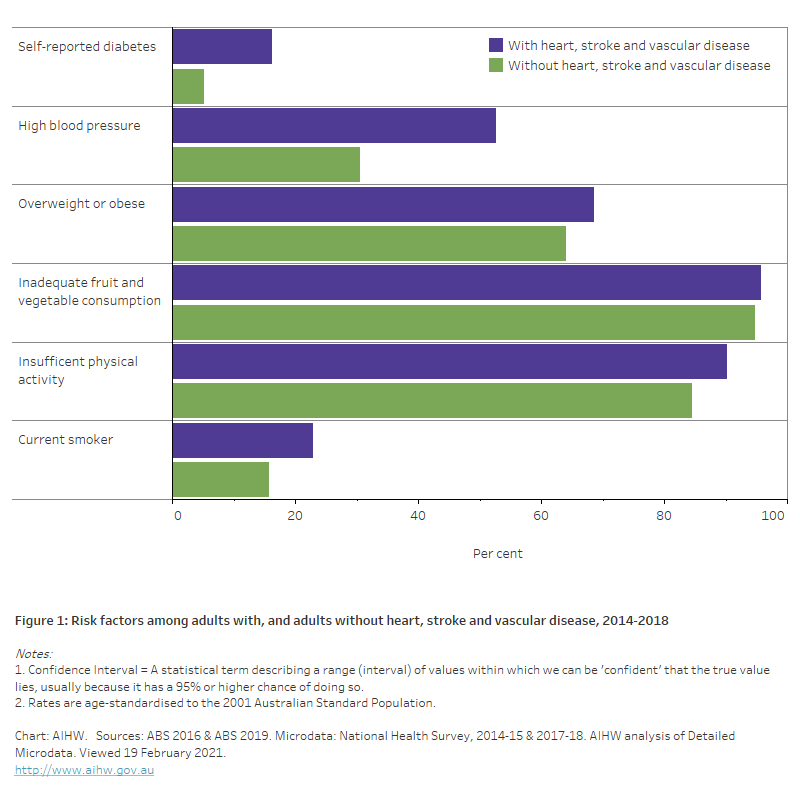People with heart, stroke and vascular disease
This section compares risk factor levels among people who report having heart, stroke and vascular disease and those who do not.
The populations with and without heart, stroke and vascular disease were obtained by pooling self-reported data on long-term health conditions from the ABS 2014–15 and 2017–18 National Health Surveys (ABS 2016, ABS 2019).
Adults who had heart, stroke or vascular disease in the 2014–15 and 2017–18 National Health Surveys had statistically significantly higher levels of current smoking, insufficient physical activity, high blood pressure and self-reported diabetes, than adults who did not have heart, stroke or vascular disease.
Higher levels of risk factors among people who have developed cardiovascular disease highlight the need for secondary prevention to limit increased severity or the occurrence of additional cardiovascular disease events.
Behavioural risk factors
After adjusting for different population age structures,
- an estimated 23% of adults who had heart, stroke and vascular disease in the 2014–15 and 2017–18 National Health Surveys were current smokers, 1.5 times as high as adults without heart, stroke and vascular disease who were current smokers (Figure 1)
- 90% of adults with heart, stroke and vascular disease were inactive or insufficiently active, 1.1 times as high as the adults without heart, stroke and vascular disease who were inactive or insufficiently active
-
96% of adults with heart, stroke and vascular disease did not consume an adequate amount of fruit and vegetables, similar to adults without heart, stroke and vascular disease who did not consume an adequate amount of fruit and vegetables.
Figure 1: Risk factors among adults with, and adults without heart, stroke and vascular disease, 2014–2018
The horizontal bar chart shows that in 2014–18 adults with heart, stroke and vascular disease had higher levels of key risk factors than adults without. High blood pressure was 1.7 times as high among adults with heart, stroke and vascular disease.

Biomedical risk factors
After adjusting for different population age structures:
- an estimated 69% of adults who had heart, stroke and vascular disease in the 2014–15 and 2017–18 National Health Surveys were overweight or obese, similar to adults without heart, stroke and vascular disease who were overweight or obese
- 53% of adults with heart, stroke and vascular disease had high blood pressure, 1.7 times as high as adults without heart, stroke and vascular disease who had high blood pressure
- 16% of adults with heart, stroke and vascular disease also had diabetes, more than 3 times as high as adults without heart, stroke and vascular disease who had diabetes.
Blood lipid levels were not measured in the 2014–15 or 2017–18 National Health Surveys. However, results from the 2011–12 Australian Health Survey indicate that 78% of adults with CVD had dyslipidaemia, compared with 59% among those without CVD. Levels of uncontrolled dyslipidaemia were similar among those with CVD (60%) and those without CVD (56%). More than half (57%) of people with CVD aged 18–39 had dyslipidaemia, increasing to 82% for those aged 55 and over (AIHW 2015).
References
ABS 2016. Microdata: National Health Survey, 2014–15. AIHW analysis of Detailed Microdata. Viewed 19 February 2021.
ABS 2019. Microdata: National Health Survey, 2017–18. AIHW analysis of Detailed Microdata. Viewed 19 February 2021.
AIHW 2015. Cardiovascular disease, diabetes and chronic kidney disease—Australian facts: Risk factors. Cat. no. CDK 4. Canberra: AIHW.


